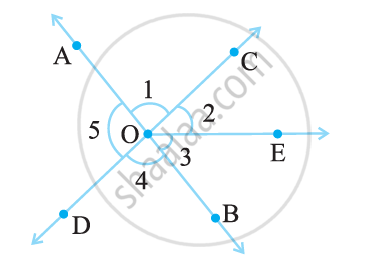Advertisements
Advertisements
Question
In the adjoining figure:
(1) Is ∠1 adjacent to ∠2?
(2) Is ∠AOC adjacent to ∠AOE?
(3) Do ∠COE and ∠EOD form a linear pair?
(4) Are ∠BOD and ∠DOA supplementary?
(5) Is ∠1 vertically opposite to ∠4?
(6) What is the vertically opposite angle of ∠5?

Solution
1) Yes. Since they have a common vertex O and also a common arm OC. Also, their non-common arms, OA and OE, are on either side of the common arm.
2) No. They have a common vertex O and also a common arm OA. However, their non-common arms, OC and OE, are on the same side of the common arm. Therefore, these are not adjacent to each other.
3) Yes. Since they have a common vertex O and a common arm OE. Also, their non-common arms, OC and OD, are opposite rays.
4) Yes. Since ∠BOD and ∠DOA have a common vertex O and their non-common arms are opposite to each other.
5) Yes. Since these are formed due to the intersection of two straight lines (AB and CD).
6) ∠COB is the vertically opposite angle of ∠5 as these are formed due to the intersection of two straight lines, AB and CD.
